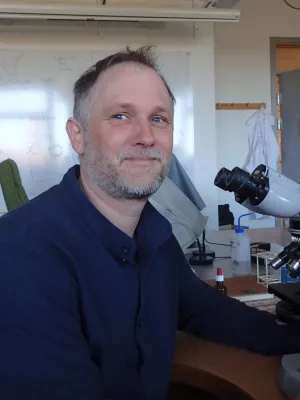
Karl Ljung
Lecturer

Rapid environmental responses to climate-induced hydrographic changes in the Baltic Sea entrance
Author
Summary, in English
The Öresund (the Sound), which is a part of the Danish straits, is linking the marine North Sea and the brackish Baltic Sea. It is a transition zone where ecosystems are subjected to large gradients in terms of salinity, temperature, carbonate chemistry, and dissolved oxygen concentration. In addition to the highly variable environmental conditions, the area is responding to anthropogenic disturbances in e.g. nutrient loading, temperature, and pH. We have reconstructed environmental changes in the Öresund during the last c. 200 years, and especially dissolved oxygen concentration, salinity, organic matter content, and pollution levels, using benthic foraminifera and sediment geochemistry. Five zones with characteristic foraminiferal assemblages were identified, each reflecting the environmental conditions for respective period. The largest changes occurred ~ 1950, when the foraminiferal assemblage shifted from a low diversity fauna, dominated by the species Stainforthia fusiformis to higher diversity and abundance, and dominance of the Elphidium group. Concurrently, the grain-size distribution shifted from clayey – to more sandy sediment. To explore the causes for the environmental changes, we used time-series of reconstructed wind conditions coupled with large-scale climate variations as recorded by the NAO index, as well as the ECOSMO II model of currents in the Öresund area. The results indicate increased changes in the water circulation towards stronger currents in the area since the 1950's. The foraminiferal fauna responded quickly (< 10 years) to the environmental changes. Notably, when the wind conditions, and thereby the current system, returned in the 1980's to the previous pattern, the foraminiferal species assemblage did not rebound, but the foraminiferal faunas rather displayed a new equilibrium state.
Department/s
- Quaternary Sciences
- Environmental Science
- Division aquatic ecology
- Aquatic Ecology
Publishing year
2019
Language
English
Pages
3835-3852
Publication/Series
Biogeosciences
Volume
16
Document type
Journal article
Publisher
Copernicus GmbH
Topic
- Oceanography, Hydrology, Water Resources
- Ecology
Status
Published
Project
- Drivers and Impacts of Coastal Ocean Acidification
- Lund University Centre for studies of Carbon Cycle and Climate Interactions
Research group
- Aquatic Ecology
ISBN/ISSN/Other
- ISSN: 1726-4189

